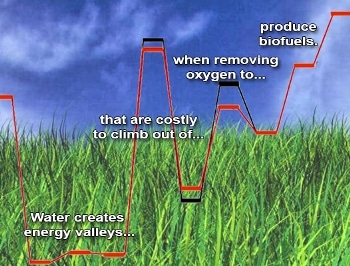Jul 11 2016
In the development of fuels from agricultural waste and other biomass, water slows the potential of a solid acid catalyst to successfully carry out its task, and this process uses a lot of energy and is time consuming. However, scientists were unaware of how the unpleasant reactions took place. This mystery was explored by a team from a major German university and Pacific Northwest National Laboratory (PNNL).
 The team eliminated two common speculations on the role of water with zeolite catalysts. Namely, they showed that water does not affect the stability of acid sites (or change their acid strength), and water does not competitively compete for the active site. CREDIT: Image courtesy of Pacific Northwest National Laboratory. Energy curve from JACS article, copyright American Chemical Society.
The team eliminated two common speculations on the role of water with zeolite catalysts. Namely, they showed that water does not affect the stability of acid sites (or change their acid strength), and water does not competitively compete for the active site. CREDIT: Image courtesy of Pacific Northwest National Laboratory. Energy curve from JACS article, copyright American Chemical Society.
The team focused on examining how water obstructs two oxygen-removal paths operated by a zeolite catalyst, because the removal of oxygen is extremely important to produce biofuel. Both of the pathways are blocked by water, and the team unequivocally illustrated that water enables the development of a highly stable intermediate.
The process of changing this intermediate into a specific product is similar to pushing a boulder uphill. A lot of energy is consumed because of the interference caused by water. As far as the production is concerned, the addition of energy is expensive in environmental and economic terms.
Water is ubiquitous and abundant in biomass-derived feedstocks. Understanding water's impact is crucial to the design and synthesis of catalytic materials that are less or not negatively affected by water.
Dr. Hui Shi, Postdoctoral Fellow, PNNL
Why It Matters
It is possible to enhance renewable biomass sources into liquid fuels by removing oxygen atoms, often from intermediately formed alcohols. This process is called dehydrating an alcohol, when catalyzed by acids. The team’s in depth study of two model dehydration pathways will be of use to those carrying out fine adjustments to decrease the cost of biofuel production.
The research illustrates how the required information can be obtained.
Researchers really need to combine experiments and theory to build models that fully describe the entire reaction, however simple it may seem. It pays off when it comes to rational catalyst and process design, which ought to be more knowledge based than empirical.
Dr. Donald Camaioni, PNNL
Methods
The team used rigorous spectroscopic, calorimetric and kinetic methods to understand the two pathways - the dimer path and the monomer path - from a molecular-level perspective. The final measurements were integrated with complex calculations. The results highlighted the moving, merging, forming and releasing of molecules in the two pathways and the volume of energy that was consumed.
We would not have succeeded without using this integrated approach.
Dr. Hui Shi, Postdoctoral Fellow, PNNL
The team performed experiments using two major methods. Infrared spectroscopy provides information by exploiting how light in the infrared region is absorbed by molecules. Thermogravimetry-differential scanning calorimetry describes the chemical and physical properties of the molecules as a basis of increasing temperature. Experiments were planned with a variety of conditions also including greater pressures in comparison to literature precedents. The team used a clean sample without any interfering structural factors for their experiments.
The findings confirmed the relative population, including the energetics, of the major surface intermediates that fall under the reaction conditions. A single propanol molecule moves into the active site of the catalyst for the monomer pathway. It then attaches to the active site and picks up a proton. Water helps to develop an intermediate even though it breaks off. It moves towards to a nonsymmetrical molecule that has a proton bridge to the catalyst. The active site of the catalyst remains inactive until the intermediate is untethered, developing the required propene.
Two propanol molecules move into the active site for the dimer pathway, and this leads to a charged two-part, or dimer, species that is extremely firm. The addition of energy at this point cuts the right bonds to develop an intermediate that resends protons to the catalyst and then discharges both propanol and water. This intermediate seems to differ when compared to that developed in the monomer path. The energy requirements also seem to vary.
The team did not cut corners by assuming that conclusions reached in one catalytic system would necessarily hold true for another.
Dr. Donald Camaioni, PNNL
What's Next?
The water was in the gas phase in this study. For their next study, the team plan to work with liquid water instead of steam. This research is part of an existing program financially supported by the Office of Science at the U.S. Department of Energy. The program aims at overcoming the basic questions that are preventing the development of cost-effective, efficient and rapid methods to produce biofuels.